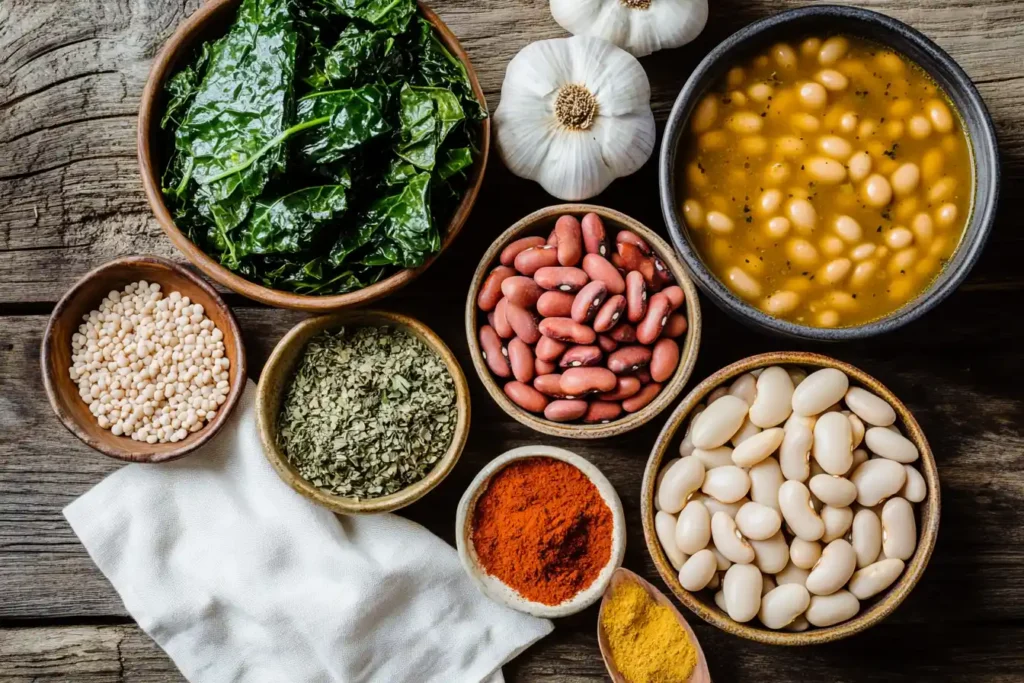Discovering the Swamp Soup Recipe
Origins and History of Swamp Soup
Swamp soup has deep roots in Southern cuisine, a region known for its comforting and resourceful recipes. Born from a tradition of using what’s readily available, this dish combines humble ingredients like leafy greens, beans, and sausage to create something extraordinary. The name “swamp soup” might sound quirky, but it’s inspired by the soup’s rich green hue, reminiscent of the verdant Southern wetlands.
Historically, this dish was a staple for families who needed to stretch their meals while keeping them delicious and filling. Today, it’s celebrated not just for its practicality but for its irresistible taste and versatility. With its roots in Southern tradition, swamp soup continues to evolve while remaining a beloved comfort food.
Cultural Significance in Southern Cuisine
The swamp soup recipe is more than just a meal; it’s a testament to Southern ingenuity and hospitality. It’s the kind of dish that brings people together, often served at family gatherings, church potlucks, or special occasions. Southerners take pride in their ability to create something hearty and satisfying from simple ingredients, and swamp soup exemplifies this perfectly.
Its adaptability also adds to its charm. Whether it’s turnip greens, collard greens, or kale, swamp soup embraces whatever greens you have on hand, making it an ideal recipe for those who value sustainability and flavor. And let’s not forget the subtle smoky undertones from the sausage, which make every bite a true delight.
Ingredients and Preparation
Essential Ingredients for Swamp Soup

Making the perfect swamp soup recipe begins with gathering the right ingredients. Each component plays a vital role in building the soup’s robust flavor and hearty texture. Let’s take a closer look at what you’ll need to create this Southern gem.
Selection of Greens
Leafy greens are the heart of swamp soup, providing its signature color and earthy flavor. Traditional options include turnip greens, collard greens, or kale, though mustard greens can add a delightful peppery kick. Choose greens that are fresh, crisp, and deep green in color for the best results.
Choice of Proteins
The smoky, savory depth of swamp soup comes from its protein. Smoked sausage is a classic choice, lending a rich and meaty flavor. For a leaner alternative, consider chicken sausage or turkey sausage. You can also try plant-based sausage options for a vegetarian twist.
Beans and Legumes
Beans bring creaminess and heartiness to the dish. White beans like cannellini or navy beans are excellent options. Some variations use black-eyed peas for a Southern touch. If you’re aiming for extra texture, consider adding chickpeas or lentils.
Aromatics and Spices
Aromatics such as garlic, onions, and celery form the flavorful base of the soup. Complement these with spices like paprika, crushed red pepper, and black pepper for a warm, comforting kick. Don’t forget the bay leaves—they add a subtle depth that elevates the broth.
Step-by-Step Preparation Guide
Preparing the Ingredients
Begin by washing and chopping your greens thoroughly. Remove any tough stems to ensure the greens cook evenly. Dice the onion, mince the garlic, and slice the sausage into bite-sized pieces. Drain and rinse your beans if using canned varieties.
Cooking Process

- Heat a large pot over medium heat and drizzle in a bit of olive oil. Sauté the onions and garlic until they’re fragrant and golden.
- Add the sausage slices and cook until slightly browned, releasing their smoky flavors into the pot.
- Stir in the beans, greens, and spices, ensuring everything is evenly coated.Pour in chicken or vegetable broth until the ingredients are submerged, similar to how you would prepare a cream of turkey soup recipe.
- Bring the mixture to a boil, then reduce the heat and let it simmer for about 30 minutes. This allows the flavors to meld beautifully.
Tips for Achieving Optimal Flavor
- For a thicker consistency, mash some of the beans against the side of the pot during cooking.
- Add a splash of apple cider vinegar or a squeeze of lemon juice at the end for a tangy brightness that balances the richness of the soup.
- Taste and adjust the seasoning with salt and pepper as needed.
Variations and Serving Suggestions
Popular Variations of Swamp Soup

One of the best things about the swamp soup recipe is its versatility. With a few simple tweaks, you can transform the dish to suit your dietary preferences or highlight regional flavors. Here are some popular variations to inspire you.
Vegetarian and Vegan Options
For a plant-based version, replace the sausage with vegan sausage or smoked tofu for that signature smoky flavor. You can also skip the protein entirely and double up on beans or legumes. Opt for vegetable broth instead of chicken broth to keep the soup 100% vegan. Nutritional yeast can be added for a cheesy, umami kick.
Seafood-Infused Swamp Soup
Add a coastal twist to your swamp soup by incorporating seafood. Shrimp, crab meat, or even chunks of firm white fish like cod or halibut can elevate the dish. Simply add the seafood during the last few minutes of cooking to prevent overcooking.
Regional Twists and Additions
Different parts of the South bring their own flair to swamp soup. Some cooks add okra for a thicker texture and a quintessential Southern vibe. Others include diced sweet potatoes or corn for a touch of sweetness. Experimenting with these regional variations ensures your soup always feels fresh and exciting.
Serving and Pairing Suggestions
Swamp soup is a meal in itself, but thoughtful accompaniments can take your dining experience to the next level. Here’s how to serve it like a pro.
Ideal Accompaniments
Cornbread is the traditional partner to swamp soup, providing the perfect balance of sweetness and texture, as seen in this cowboy cornbread recipe. Serve it warm, with a drizzle of honey or a pat of butter. For a lighter option, pair the soup with a simple green salad dressed with vinaigrette.
Presentation Tips
Make your swamp soup look as irresistible as it tastes. Ladle it into a rustic bowl, ensuring every serving has a generous mix of greens, beans, and sausage. Garnish with freshly chopped parsley or green onions for a pop of color. Serve with a side of crusty bread or crackers for dipping, making every bite a cozy delight.
sugar levels, improve gut health, and support weight management. Plus, their creamy texture makes every spoonful of soup a delight.
Nutritional Information and Health Benefits
Nutritional Profile of Swamp Soup
Swamp soup isn’t just delicious; it’s also packed with nutrients that make it a wholesome addition to your meal plan. This section will explore the nutritional breakdown of this hearty dish, highlighting why it’s as good for your body as it is for your soul.
| Nutrient | Amount |
|---|---|
| Calories | 80 kcal |
| Protein | 4.5 g |
| Carbohydrates | 6.3 g |
| Fiber | 2.1 g |
| Fat | 3.2 g |
| Vitamin A | 600 IU |
| Vitamin C | 18 mg |
| Calcium | 40 mg |
| Iron | 1.1 mg |
Caloric Content
A serving of swamp soup is typically low in calories, making it a guilt-free indulgence. Depending on the ingredients used, a single bowl averages around 200-300 calories. By opting for leaner proteins like chicken sausage or plant-based alternatives, you can further reduce the calorie count without sacrificing flavor.
Macronutrient Breakdown
Swamp soup strikes a healthy balance of macronutrients:
- Protein: Thanks to sausage and beans, this dish is a great source of protein, essential for muscle repair and energy.
- Carbohydrates: Beans and legumes contribute complex carbohydrates, providing slow-releasing energy.
- Fats: Moderate fat content from the sausage adds richness, while olive oil offers heart-healthy unsaturated fats.
Vitamins and Minerals
Leafy greens like collards and turnip greens are nutrient powerhouses:
- Rich in vitamin K, which supports bone health.
- Packed with vitamin C, boosting immunity.
- High in iron, essential for oxygen transport in the body.
Beans add a dose of potassium and magnesium, which are key for heart health and muscle function.
Health Benefits of Key Ingredients
Each ingredient in swamp soup brings unique health benefits, making it a nourishing choice for the entire family.
Benefits of Leafy Greens
Leafy greens are the star of this dish. They’re known to reduce inflammation, support heart health, and promote better digestion. Greens like collards and kale are also low in calories but high in fiber, keeping you full and satisfied.
Protein Sources and Their Advantages
Using sausage or leaner protein options like turkey or chicken sausage provides a rich source of protein. Protein is vital for maintaining muscle mass and keeping you energized throughout the day. Smoked sausage also imparts a deep, savory flavor without requiring additional fats or oils.
Role of Legumes in a Balanced Diet
Legumes, such as cannellini beans or black-eyed peas, are an excellent source of plant-based protein and fiber. They’re known to help regulate blood sugar levels, improve gut health, and support weight management. Plus, their creamy texture makes every spoonful of soup a delight.
Frequently Asked Questions About Swamp Soup
Every soup enthusiast knows that the “secret ingredient” can elevate a dish from good to unforgettable. For swamp soup, the secret lies in the smoked sausage. Its smoky, savory flavor infuses the broth, creating a depth that’s hard to replicate. Another lesser-known secret is adding a splash of apple cider vinegar at the end, which brightens the flavors and balances the richness of the greens and beans.
While opinions may vary, many consider swamp soup one of the most comforting and flavorful soups, especially in the South. Globally, soups like pho (Vietnamese noodle soup), tom yum (Thai spicy soup), and French onion soup are often celebrated for their unique flavor profiles.
Three Sisters soup is rooted in Native American culinary traditions and features the “three sisters” crops: corn, beans, and squash. These three ingredients are considered sacred and complement each other both agriculturally and nutritionally. Typically, the soup includes diced squash (butternut or acorn), kernels of sweet corn, and kidney or pinto beans. Additional ingredients like onions, garlic, and herbs enhance its rich, earthy flavor.
Turnip green soup, a close cousin to swamp soup, is loaded with nutrients. A single serving typically contains:
Calories: 150–250, depending on the recipe.
Fiber: High, aiding in digestion and keeping you full longer.
Vitamin A: Promotes eye health and boosts immunity.
Calcium: Supports strong bones and teeth.
Iron: Essential for energy production and healthy blood.
Conclusion For Swamp Soup
The swamp soup recipe is much more than a simple dish; it’s a celebration of Southern ingenuity and flavor. Its combination of hearty greens, smoky sausage, and creamy beans creates a wholesome, comforting meal that’s as nourishing as it is delicious. Whether you’re exploring its roots in Southern cuisine, customizing it with regional twists, or simply enjoying its rich flavors, this soup has something for everyone.
From its humble origins to its status as a beloved classic, swamp soup embodies the essence of home cooking: resourceful, flavorful, and made to bring people together. With its versatility and ease of preparation, it’s the perfect recipe for a weeknight dinner or a festive family gathering.
So, gather your ingredients, fire up your stove, and let the magic of swamp soup transform your kitchen. And remember—sometimes, the simplest ingredients create the most unforgettable meals. Enjoy!

